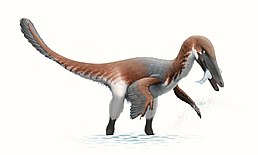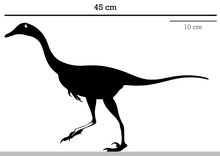Unenlagiidae
Stratigrafický výskyt: Svrchní křída, asi před 94 až 70 miliony let | |
|---|---|
 Austroraptor, zástupce skupiny | |
| Vědecká klasifikace | |
| Říše | živočichové (Animalia) |
| Kmen | strunatci (Chordata) |
| Třída | plazi (Sauropsida) |
| Nadřád | dinosauři (Dinosauria) |
| Řád | plazopánví (Saurischia) |
| Podřád | teropodi (Theropoda) |
| Infrařád | celurosauři (Coelurosauria) |
| Čeleď | Unenlagiidae Bonaparte, 1999 |
| Některá data mohou pocházet z datové položky. | |
Čeleď unenlagidů byla skupinou dravých (teropodních) dinosaurů náležejících do blízkého příbuzenstva dromeosauridů (resp. jedná se pravděpodobně o podskupinu specializovaných dromeosauridů).[1]
Popis

Byli to aktivní a rychlí lovci obvykle menších rozměrů, velmi podobní ptákům. Pravděpodobně byli všichni opeření a někteří možná dokázali využívat klouzavý let (například rod Rahonavis). Jejich fosilní pozůstatky byly dosud objeveny v Asii, Jižní Americe i na Madagaskaru. Žili v období pozdní křídy, zhruba před 94 až 70 miliony let.[2]
Zařazení
Dnes do této čeledi řadíme podčeledi Halszkaraptorinae a Unenlagiinae, typovým druhem je Unenlagia comahuensis, formálně popsaná roku 1997.[3] Některé druhy byly pravděpodobně vysoce specializované pro obojživelný či na blízkost vody vázaný způsob života (např. Halszkaraptor escuillei).[4]
Odkazy
Reference
- ↑ SOCHA, Vladimír. Mocný dinosauří válečník z Antarktidy. OSEL.cz [online]. 28. listopadu 2024. Dostupné online. (česky)
- ↑ Matías J. Motta; Federico L. Agnolín; Federico Brissón Egli; Fernando E. Novas (2020). "New theropod dinosaur from the Upper Cretaceous of Patagonia sheds light on the paravian radiation in Gondwana". The Science of Nature. 107 (3): Article number 24. doi: 10.1007/s00114-020-01682-1
- ↑ SOCHA, Vladimír. 40 let s dinosaury. OSEL.cz [online]. 30. prosince 2021. Dostupné online. (česky)
- ↑ Cau, Andrea (2020). "The body plan of Halszkaraptor escuilliei (Dinosauria, Theropoda) is not a transitional form along the evolution of dromaeosaurid hypercarnivory". PeerJ. 8: e8672. doi: 10.7717/peerj.8672
Literatura
- Gianechini, Federico A. (2011). "Unenlagiinae revisited: dromaeosaurid theropods from South America". Anais da Academia Brasileira de Ciências. Ciudad Autónoma de Buenos Aires, Argentina: Brazilian Academy of Sciences. 83 (1): 163–195.
- Cau, A.; Beyrand, V.; Voeten, D.; Fernandez, V.; Tafforeau, P.; Stein, K.; Barsbold, R.; Tsogtbaatar, K.; Currie, P.; Godrfroit, P. (2017). "Synchrotron scanning reveals amphibious ecomorphology in a new clade of bird-like dinosaurs". Nature. 552 (7685): 395–399. doi: 10.1038/nature24679
- Federico A. Gianechini, Marcos D. Ercoli & Ignacio Díaz-Martínez (2019). The locomotor and predatory habits of unenlagiines (Theropoda, Paraves): inferences based on morphometric studies and comparisons with Laurasian dromaeosaurids. bioRxiv 553891. doi: https://doi.org/10.1101/553891
- E. Novas, Matías J. Motta, Federico L. Agnolín, Sebastián Rozadilla, Gastón E. Lo Coco and Federico Brissón Egli (2021). Comments on the Morphology of Basal Paravian Shoulder Girdle: New Data Based on Unenlagiid Theropods and Paleognath Birds. Frontiers in Earth Science. 9: 662167. doi: https://doi.org/10.3389/feart.2021.662167
Externí odkazy
- Informace na webu DinoData (anglicky)
- Článek na webu Waxing Paleontological (anglicky)
- Článek na webu Sci-News (anglicky)
Média použitá na této stránce
Autor:
- Information-silk.png: Mark James
- derivative work: KSiOM(Talk)
A tiny blue 'i' information icon converted from the Silk icon set at famfamfam.com
Autor: PaleoNeolitic, Licence: CC BY 4.0
Skeletal composite of the recently reclassified halszkaraptorine dinosaurs Hulsanpes perlei, featuring the holotype specimen ZPAL MgD-I/173 which is an immature individual. It was found in the Barun Goyot Formation of Mongolia in 1970 and described in 1982 by Halszka Osmólska. The genus was first classified as a dromaeosaurid taxon with unresolved affinities,[1] but in 2017 with the description of the peculiar genus Halszkaraptor, the Halszkaraptorinae was coined and Hulsanpes identified as a member. The holotype consist of a right metatarsus composed by II, III and IV metatarsals with three phalanges, and a partial right braincase fragment.[2]
Autor: Fred Wierum, Licence: CC BY-SA 4.0
Scientific reconstruction of Austroraptor cabazai


